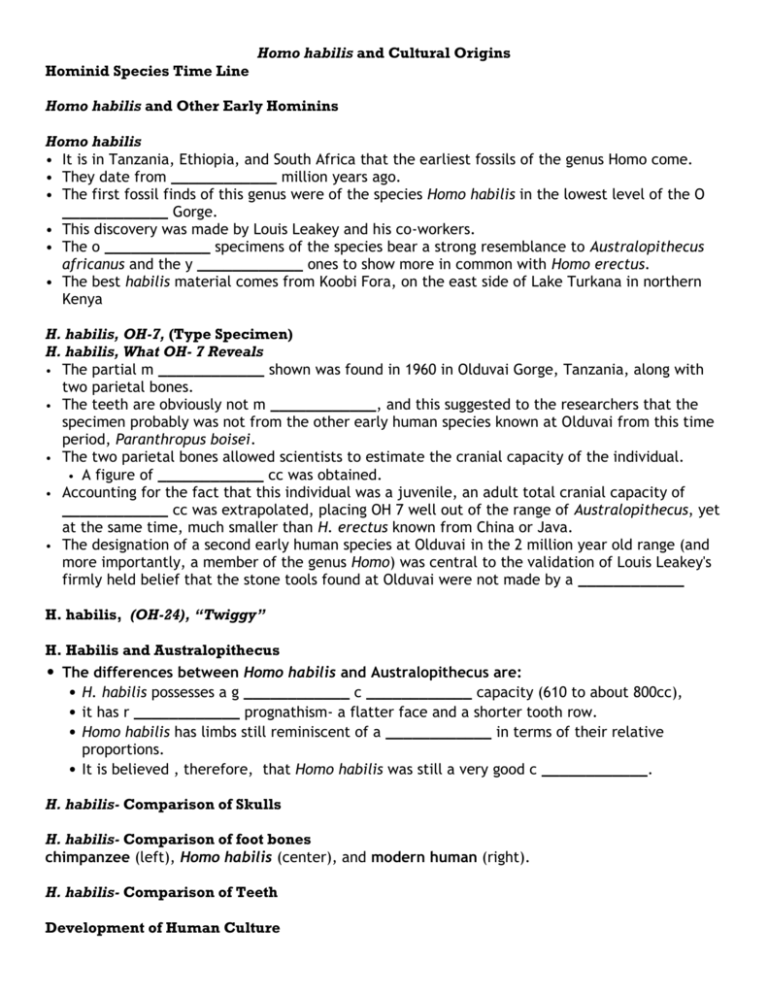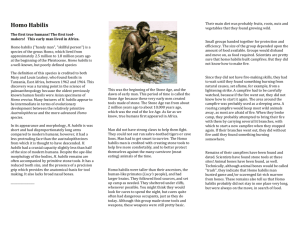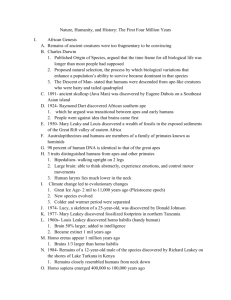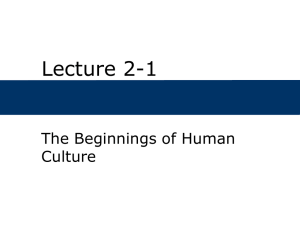Chapter 7 Homo habilis and Cultural Origins
advertisement

Homo habilis and Cultural Origins Hominid Species Time Line Homo habilis and Other Early Hominins Homo habilis • It is in Tanzania, Ethiopia, and South Africa that the earliest fossils of the genus Homo come. • They date from ____________ million years ago. • The first fossil finds of this genus were of the species Homo habilis in the lowest level of the O ____________ Gorge. • This discovery was made by Louis Leakey and his co-workers. • The o ____________ specimens of the species bear a strong resemblance to Australopithecus africanus and the y ____________ ones to show more in common with Homo erectus. • The best habilis material comes from Koobi Fora, on the east side of Lake Turkana in northern Kenya H. habilis, OH-7, (Type Specimen) H. habilis, What OH- 7 Reveals • The partial m ____________ shown was found in 1960 in Olduvai Gorge, Tanzania, along with two parietal bones. • The teeth are obviously not m ____________, and this suggested to the researchers that the specimen probably was not from the other early human species known at Olduvai from this time period, Paranthropus boisei. • The two parietal bones allowed scientists to estimate the cranial capacity of the individual. • A figure of ____________ cc was obtained. • Accounting for the fact that this individual was a juvenile, an adult total cranial capacity of ____________ cc was extrapolated, placing OH 7 well out of the range of Australopithecus, yet at the same time, much smaller than H. erectus known from China or Java. • The designation of a second early human species at Olduvai in the 2 million year old range (and more importantly, a member of the genus Homo) was central to the validation of Louis Leakey's firmly held belief that the stone tools found at Olduvai were not made by a ____________ H. habilis, (OH-24), “Twiggy” H. Habilis and Australopithecus • The differences between Homo habilis and Australopithecus are: • H. habilis possesses a g ____________ c ____________ capacity (610 to about 800cc), • it has r ____________ prognathism- a flatter face and a shorter tooth row. • Homo habilis has limbs still reminiscent of a ____________ in terms of their relative proportions. • It is believed , therefore, that Homo habilis was still a very good c ____________. H. habilis- Comparison of Skulls H. habilis- Comparison of foot bones chimpanzee (left), Homo habilis (center), and modern human (right). H. habilis- Comparison of Teeth Development of Human Culture Homo habilis and Cultural Origins When did it happen? • Some populations of early hominines began making s ____________ t ____________ to butcher animals for their meat. • The earliest stone tools and evidence of significant meat eating date to about ____________ m.y.a. Reorganization and Expansion Of The Human Brain • Began at least 1.5 million years a ____________ the development of bipedal locomotion. • Began in c ____________ with scavenging and the making of stone tools. • Marks the appearance of the genus Homo, an evolutionary offshoot of Australopithecus. Reorganization And Expansion Of The Human Brain • Australopithecus relied on a v ____________ diet while developing a massive chewing apparatus. • Homo ate more m ____________ and became brainier. Tools, Food, and Brain Expansion • Increased consumption of meat, beginning about 2.5 m.y.a. made new demands on coordination and behavior. • Procuring meat depended on the ability to o ____________ more predators and scavengers. • Eaters of high-protein foods do not have to eat as o ____________ as vegetarians, leaving time to explore and experiment with their environment. Brain Structure and Tool Use • Tool making favored the development of a more complex brain: • Requires a v ____________ of the tool to be made. • Ability to r ____________ the kind of stone that can be worked. • Requires steps to t ____________ the raw material into a useful tool. H. habilis and Tool Making • The giant increase in brain size made by habilis would have given the species the advantage of stone tool-making. • Stone t ____________ and cut animal b ____________ have been found associated with Homo habilis. • Tool-making also leads to the beginning of c ____________. • Homo habilis is also thought to have possessed a locomotion more human in attributes than that of the australopithecines.. H. Habilis and Olduwan Tools The Core and the Flake Olduwan Tool Making The Emergence of Homo • • Homo habilis and Cultural Origins The genus Homo emerged between 2 and 1.8-1.7 million years ago: H. rudolfensis, H. habilis, and H. ergaster, an early form of H. erectus; they probably evolved from one of the non-robust species, perhaps A. garhi. Larger b ____________, smaller j ____________ and t ____________ and a decrease in s ____________ d ____________ ____________ are among their characteristics. THE FIRST STONE TOOLS AND THE OLDOWAN • The earliest archaeological materials and sites, dated to 2.5 million years ago, are referred to as the O ____________ industry, after Louis and Mary Leakey's work at Olduvai Gorge in Tanzania. • Cores, flakes, hammerstones, and sometimes retouched pieces were divided by M ____________ L ____________ into heavy and light duty tools, and Oldowan and Developed Oldowan industries • She and others argued for complex strategies and preparation, but such arguments are not convincing. THE FIRST STONE TOOLS AND THE OLDOWAN Technology • Experimentation has shown that these artifact "types" can be explained by least-effort flaking strategies and variation in raw materials. • At Swartkrans and Sterkfontein in South Africa, polished and striated bone and horn fragments associated with Oldowan artifacts have been interpreted as d ____________ implements, reminding us that much of the early hominins' material culture would have been o ____________ and p ____________. Who Made the Oldowan Tools? • Perhaps eight hominin species are found in Africa for the period for which the first stone tools are known, both australopithecines and early forms of Homo. • So which made the tools? The fossil record is unfortunately quite s ____________. • Then in 1997 a new hominin, Australopithecus g ____________, was discovered, which is considered by many to have made Oldowan tools. Hunters or Scavengers? • Conversely, Lewis Binford argued that the sites were carnivore kills s ____________ by hominins, who took m ____________ because little else was left. • Blumenschine argued that the body part representation and cut mark location/frequency were most consistent with o ____________ scavenging. • Henry Bunn, Manuel Dominguez-Rodrigo, and Travis Pickering disagreed, arguing from the same type of data that hominins h ____________ or drove predators from nearly complete carcasses. • Discovery and evaluation of new sites will lead to a clearer picture, and probably show that behavior was c ____________, with a r ____________ of different strategies. Hunting vs. Scavenging Lewis Binford-• Majority of bones are lower extremities • Left after c ____________ feasts • Tools work well for getting a m ____________ cavity Pat Shipman -- Homo habilis and Cultural Origins • • • • Microscopic cut marks Carnivore tooth marks o ____________ cut marks Cut marks not at the j ____________ Omnivore dental wear patterns Food for Thought: Diet and Encephalization • In 1995, Leslie Aiello and Peter Wheeler proposed the "e ____________ t ____________ " hypothesis: • animals with low-nutrient plant diets and complex digestive tracts devote more metabolic energy to digestion, while carnivores and omnivores with high-protein diets have simpler digestion, allowing energy expenditure on evolving larger brains. • Therefore, among hominins, meat/marrow consumption, brain expansion, and tool use may all have evolved together. • Homo habilis sites appear to show i ____________ m ____________ procurement, and the species displays significant b ____________ enlargement, possibly supporting the hypothesis, which could be tested through bone chemistry analysis. THE BEHAVIOR OF OLDOWAN HOMININS • S ____________ tools are the best p ____________ evidence for hominin behavior, but many behaviors would have left few visible artifacts. • Some of these, though, can be deduced. Social Organization • Hominin social organization can be inferred through m ____________ primate behavior and hominin f ______. • Sexual dimorphism suggests that m ____________ competed for f __________ • Fossil finds suggest they lived in multi-male, multi-female groups of perhaps ____________ individuals. Diet • The l ____________, pitted teeth of robust australopithecines suggest a diet of hard, gritty foods. • The more gracile australopithecines and early Homo forms may have had a more generalized diet. • Bone chemistry may clarify this. • Hammerstone blows and cut marks on large mammal long bones show that Oldowan hominins ate at least some m ____________ and m ____________. • Chimpanzees and baboons prey on much smaller animals, suggesting that tools facilitated new adaptations. Technology • Like chimpanzees, hominins probably used more tools than the stone forms preserved: • animal skins. ostrich eggshells, tortoise carapaces may have been used as c ____________ • bones, horns, tusks, or branches could have been employed as d ____________ tools • clubs, sharpened wood as s ____________, Homo habilis and Cultural Origins • unmodified stones as p ____________. Fire • Controlled use of fire by Oldowan hominins is c ____________ . • Thermally altered sediments and burned bones are found in layers associated with stone tools and cut-marked bones. • Yet in the a ____________ of a discrete h ____________ or concentrations of burning and artifacts, it is difficult to rule out natural fires. Site Modification • At present, ____________ Oldowan architectural features are known. • Circular stone features once described as hut remains are now thought to be natural. • Modern apes build arboreal and terrestrial n ____________, and early hominins probably had similar behaviors. Art, ritual, and language • Currently, there is ____________ direct evidence for symbolic behavior among Oldowan hominins. • Prefrontal cortex expansion in Homo habilis occurred shortly after 2 million years ago • This might mark the beginning of: • s ____________ communication • introduction of stone tools • c ____________ behavior. RECENT TRENDS IN APPROACHES TO THE OLDOWAN • Recently, Oldowan research has shifted from artifact c ____________ and typologies, toward inferring hominin b ____________ and adaptive strategies. Classification Behavior Experimental Studies of Stone Tool Use • E ____________ using Oldowan-type artifacts for tool-making, animal butchery, marrow processing, woodworking, nut cracking and other activities illuminate the f ____________ of certain tools for certain functions, as well as cut mark, fracture pattern, and use wear creation. Experiments in Site Formation Processes • Geological forces can b ____________ and alter sites. • Experiments can help determine if sites are primary (little disturbed) or secondary (drastically changed). • Artifact types present and their orientation, among other factors, can reveal the degree of disturbance, for example by w ____________. • Other researchers study the affect of site location. • Yet others study carnivore k ____________ -sites, determining what would have been available for hominins to scavenge. Olduwan Technologies: • • • • Homo habilis and Cultural Origins Olduwan lithic technologies are evident in the paleontological record between 2.5 MY and 1.5 MY before contact. Olduwan tools were made by using various p ____________ techniques to remove flakes from a core stone. The f ____________, and sometimes the c ____________, could then be used as tools. There were four principle techniques of manufacture. OLDOWAN CHOPPER CORES OLDUVAI GORGE, TANZANIA AFRICA Hard hammer percussion: • a hammer stone was held in the d ____________ hand • (forensic evidence shows that by this time ____________ % of tool makers were righthanded) and hit the core stone in the other hand. • This was the most common technique. Hard hammer percussion: • KANZI THE CHIMP MAKING A STONE FLAKE TOOL THAT HE WILL USE TO OPEN A BOX OF FOOD OLDOWAN FLAKE TOOL OLDUVAI GORGE, TANZANIA AFRICA Bipolar: • The core stone was balanced on a hard surface, such as a large boulder, and hit with the hammer. • This technique removed flakes from b ____________ e ____________ of the core. • It is thought to have been used when there was a significant risk of the core shattering under impact. Anvil technique: • The core stone was held in both hands and forcefully swung at a large anvil. • This technique was used when the core stone was t ____________ l ____________ to be comfortably held in one hand, but involved a significant risk that fragments would impact the hominid using this technique. Throwing: • This technique is the c ____________, and one of the most commonly used by proto-clients. • The core stone is simply thrown at some suitable anvil. • This technique is not capable of producing as sharp an edge as the others and was the least commonly used by hominids. Making tools is dangerous! • All techniques involved some risk of industrial i ____________. • Unsuspected weaknesses in the stones would produce high velocity shrapnel which could cause significant injuries. • Homo habilis and Cultural Origins Also, the resulting dust would inevitably damage the lungs. Making tools is dangerous! • Olduwan tool makers were probably o____________ and u____________. • However, much more advanced technologies probably produced specialized stone knappers. • These specialists may have been risking silicosis. • In general, stones with glass or ceramic properties produce s____________ tools. Tools were used for several purposes. • Nut c ____________ was done by almost the same method as used in the biploar technique. This could significantly improve the range of foodstuffs available to early hominids. • W ____________ was another probable application. • Branches naturally fallen from trees are too weak to be used as effective digging sticks. • Instead sharp flakes were used to sever the branches and to shape the severed branches. Tools were used for several purposes • • • Stone tools also allowed the immediate penetration of pachyderm s ____________. Most other animals were unable to bite through these thick skins and had to wait until the flesh had started to rot, but hominids used Olduwan grade tools to cut the skin away, (though probably not preserving it for use as clothing or shelter at this developmental level) and to fillet the pachyderm. Even the crudest tools could be used to e ____________ m ____________ from bones using the basic hammer-and-anvil nut-cracking technique, providing a valuable source of nutrients -especially fat. (by Robert Shaw) Tool Use • Lower Paleolithic artifacts from Olduvai Gorge, Lake Turkana, and sites in Ethiopia required skill and knowledge for their manufacture. • The oldest Lower Paleolithic tools found at Olduvai are in the Oldowan tool tradition. • Oldowan choppers and flakes made the regular addition of meat to the diet possible. H. habilis H. habilis and Speech? • Brain specialists see in c ____________ from habilis skulls the bulge of Broca's area. • This bulge was not found in earlier hominids. • This region is essential to s ____________; and so it is believed that habilis was probably equipped for rudimentary speech. H. habilis and Speech? Language Origins • There is a growing consensus that all great apes share an ability to develop language skills to the level of a 2- to 3-year-old human. • In the wild, apes display language skills through g ____________. Language Origins • • • Homo habilis and Cultural Origins Regions of the human brain that control language lie a ____________ to regions involved in precise h __________ control. Oldowan toolmakers, like modern humans, were overwhelmingly right-handed. In making tools, they gripped the core in the l ____________ hand, striking flakes off with the r ____________. Language Origins • H ____________ is associated with l ____________ of brain functions and lateralization is associated with l ____________. • Tool making appears to have been associated with changes in the brain necessary for language development. • This theory was first written about by Stanley Ambrose (2001,"Paleolithic technology and human evolution." Science 291: 1748-1753.) • http://www.news.uiuc.edu/scitips/01/03evolution.html Alternate Views of Early Human Evolution






